Professional Practice
Resource Guides
Climate Change and Resilience | Health and Well-being | Universal Design | Sustainable Planning and Design | Sustainable Residential Design
Climate Change and Resilience
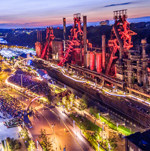
Climate Change Mitigation and Landscape ArchitectureLandscape architects are helping to shift us to a carbon neutral future. They plan and design dense, walkable communities that reduce emissions from transportation and sprawl. They make the built environment more energy and carbon efficient with strategies like green roofs, water-efficient design, and use of sustainable materials and construction practices. They defend and expand carbon-sequestering landscapes such as forests, wetlands, and grasslands, helping to drawdown atmospheric carbon dioxide. All of these efforts also enable communities to better adapt to climate change by improving resilience. Explore resources.

Resilient DesignWorking with nature -- instead of in opposition to it -- helps communities become more resilient and come back stronger after disruptive natural events. Long-term resilience is about continuously bouncing back and regenerating. It's about learning how to cope with the ever-changing “new normal.” Explore resources.
Health and Well-being

Health Benefits of NatureThe idea that spending time in nature can make you feel better is
intuitive. Many of us have anecdotes of
our own or from friends or family that support that idea. People who
have been suffering from stress, sickness, or a trauma can spend quiet
contemplative time in gardens or taken to the mountains or woods to
heal. But nature is not just wilderness. The benefits of nature can also
be found in our communities’ parks and green spaces. Explore resources.
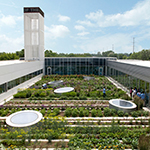
Healthy and Livable CommunitiesWorking with landscape architects, communities can promote human health and well-being by encouraging the development of environments that offer rich social, economic, and environmental benefits. Healthy, livable communities all improve the welfare and well-being of people by expanding the range of affordable transportation, employment, and housing choices through "Live, Work, Play" developments; incorporating physical activity into components of daily life; preserving and enhancing valuable natural resources; providing access to affordable, nutritious, and locally produced foods distributed for less cost; and creating a unique sense of community and place. Explore resources.
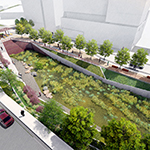
Joint Call to Action to Promote Healthy CommunitiesThe Joint Call to Action to Promote Healthy Communities (JCTA) brings together 450,000 professionals who recognize that the built environment — the way a community is designed and built from its buildings and public spaces to how we travel between communities — is a key determinant of health. The eight member organizations of the JCTA have published ten conversation guides to highlight successful cross-disciplinary collaborations for healthy, equitable communities. Each guide examines the successes and challenges of one case study and includes conversational questions any design or planning professional can use to kick-start collaboration in their community. Explore resources.
Universal Design
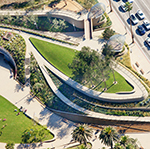
Universal DesignIf we want everyone to participate in public life, we must design and build an inclusive public realm that is accessible to all. Everyone navigates the built environment differently, with abilities changing across a person's lifespan. The sizeable global population of people with physical, auditory, or visual disabilities, autism or neurodevelopmental and/or intellectual disabilities, or neuro-cognitive disorders will face greater challenges if we don’t begin to more widely apply universal design principles. Landscape architects and designers plan and design inclusive spaces for all users. Explore resources.
Sustainable Planning and Design

Green InfrastructureThe idea that nature is also infrastructure isn't new. But it's now more widely understood to be true. Nature can be harnessed to provide critical services for communities, protecting them against flooding or excessive heat, or helping to improve air and water quality, which underpin human and environmental health. When nature is harnessed by people and used as an infrastructural system it's called "green infrastructure." Green infrastructure occurs at all scales. While it's often closely associated with green stormwater management systems, which are smart and cost-effective, it's really bigger than that. Explore resources.
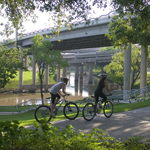
TransportationTransportation infrastructure is a vital part of the public realm. It connects us to families, friends, jobs, businesses, education, and recreation. However, conventional approaches to transportation have led to negative outcomes for people and the environment. Landscape architects are on the forefront of creating sustainable transportation systems that are low-emission, active, safe, equitable, resilient, ecological, and beautiful. Explore resources.

Sustainable Urban DevelopmentUrban development should be guided by a comprehensive planning and management vision that includes interconnected green space, a multi-modal transportation system, and mixed-use development. Diverse public and private partnerships should be used to create livable communities that protect historic, cultural, and environmental resources. In addition, policymakers, regulators and developers should support sustainable site planning and construction techniques that create a balance between built and natural systems. Explore resources.
Sustainable Residential Design

Applying Ecological Design Plants are central to a functioning global ecosystem. Homeowners can use native plants to reduce the use of excess water, energy, and chemical fertilizers and pesticides that damage natural ecosystems. Sustainable residential landscape architecture practices can help build a network of productive landscapes by using native plants communities to reconnect fragmented ecosystems in residential areas. Explore resources.

Improving Water ManagementHomeowners waste water irrigating their lawns with water that should be reserved for human consumption. Residential landscapes can be designed to both conserve water in times of water scarcity and reduce flooding during storms by using green infrastructure approaches, like bioswales and bioretention ponds; rain gardens; rain water harvesting; water recycling; and drip irrigation to better manage water. Explore resources.

Increasing Energy EfficiencyInefficient home energy use is not only costly, but also contributes to the growth of greenhouse gas (GHG) emissions, the major cause of climate change. Sustainable residential landscape architecture can increase energy efficiency and dramatically reduce energy costs over the long term while creating a healthy residential environment. Explore resources.
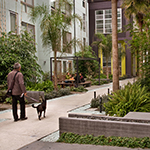
Using Low-impact MaterialsNew and non-recyclable materials used in homes and landscapes consume enormous amounts of resources to produce and distribute and create additional waste when they are demolished. Sustainable residential landscape design can significantly increase the quality of the environment through the use of innovative low-impact materials that are permeable, recycled, recyclable, reflective (high albedo), and non-toxic. Explore resources.